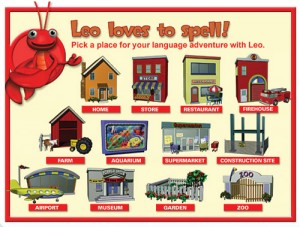As we all know, it’s never too early to encourage reading. I regularly Skype with my two young nieces, who live 1,200 miles away. The four-year-old shares her current bedtime book with me, and shows me the words she can recognize in it. While reading in person with a child is best, these apps and sites also help very young students get excited about learning to read and write.
 Building Language for Literacy (Scholastic) offers three nice little language activities, designed for preK and kindergarten students. Leo Loves to Spell! asks students to help a lobster named Leo identify the first letter of a series of spelling words arranged in 12 categories. Reggie Loves to Rhyme! features a rhinoceros that needs help identifying the words that rhyme with objects, from places including a construction site, garden, and supermarket. Nina Loves to Name Things! presents a newt that needs a hand naming objects in places such as a farm, aquarium, and firehouse. All of these activities are suited to use on an individual basis or for projection onto an interactive whiteboard to use in group lessons.
Building Language for Literacy (Scholastic) offers three nice little language activities, designed for preK and kindergarten students. Leo Loves to Spell! asks students to help a lobster named Leo identify the first letter of a series of spelling words arranged in 12 categories. Reggie Loves to Rhyme! features a rhinoceros that needs help identifying the words that rhyme with objects, from places including a construction site, garden, and supermarket. Nina Loves to Name Things! presents a newt that needs a hand naming objects in places such as a farm, aquarium, and firehouse. All of these activities are suited to use on an individual basis or for projection onto an interactive whiteboard to use in group lessons.
Writing is more fun when you have an eager, friendly audience, and a nice way for young students to develop their writing skills these days is for them to send emails to grandparents, aunts, and uncles. Maily is a free iPad app that provides a safe, fun way to do so. After setting up the Maily account, parents select and add contacts, and children may send and receive emails only from those people. The user interface is kid-friendly, and children can choose to draw pictures, use templates to create emails, and/or upload pictures. To send their emails, users click the “send” button and select the image of the person they want to receive it.
The Collins Big Cat iPad apps (HarperCollins) are part short story and part story-creation tools. Each of these eight free tools contains a tale that kids can read or have someone narrate. Kids can manipulate interactive elements on each page. Then, after reading and or listening to a story, they can create their own tale by choosing settings and characters matching the theme of what they’ve just read.
Using the story creation aspect of these apps, students can select a background, drag design features into the background, drag characters into the story, add text, and record their own narrations. To get a sense of how the apps work, check out the It Was a Cold, Dark Night story creator, in which you’ll follow along with a hedgehog as he tries to find a warm place to sleep. There’s also a quiz designed to check for understanding.
Reading Bear is a free service with narrated lessons about recognizing and pronouncing letters and words, along with lessons on prefixes and suffixes. Students can control the pace of each lesson, and also take quizzes in which they match the correct word with a picture. Through a narrator, they receive instant feedback on each question. Reading Bear presents good independent activities as well as ones involving a parent or tutor.
None of these sites and apps are replacements for in-person reading and writing lessons. But they can make practicing these skills a lot more fun.
Maily for iPad from School Library Journal on Vimeo.


